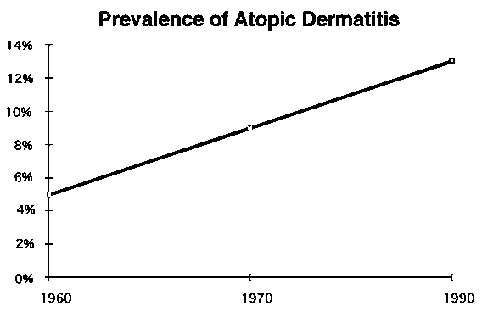
- Genetic predisposition
- Environmental factors
- Food allergens
- Respiratory allergens (house dust and mites)
- Microbial factors (Staphylococcus aureus)
- Contact allergens in the adult
- Elementary eczematous lesion
- Characteristic distribution :
- Predominent cervical involvement :
- Cheek involvement (usual noninvolvement of the mifacial region).
- Dennie Morgan's sign
A frequent but nonpathognomonic sign : a secondary crease in the lower eyelids - Postauricular lesions
- Scalp involvement (crusted eczema is often difficult to treat)
- Limb involvement :
- Localization in folds (cubital folds, popliteal fossae, neck folds)
- Involvement of the extremities (hand, thumb sucking)
- Usual avoidance of the diaper area
- Predominent cervical involvement :
- A constant sign : pruritus
Appears at the third month, and causes itchy lesions and sleep disorders. - Clinical course :
- Short-term : alternation between flare-up and remissions phases
- Long-term :
- Regression of cutaneous manifestations
- Disappearance of lesions, but persistence of disease conditions
- Nummular eczema
- Contact eczema
- Dyshidrosis
- Severe eczema in the adult
- Risk of asthma : a major risk during atopic dermatitis. Early Treatment of the Atopic Child (ETAC program) : prevention of the onset of asthma during childhood
- Regression of cutaneous manifestations
- Complication :
- Microbial superinfection
- Constant microbial colonization
- Possible bacterial infection
- Viral superinfection
- Herpes virus :
- Other viruses : Papilloma virus (common warts), Pox virus (molluscum contagiosum), Varicella-Zoster virus
- Psychoaffective repercussions
Though discrete in minor forms, they can take on considerable proportions, leading to rejection or, on the contrary, overprotection of the child by its parents.
Be careful! the child quickly realizes that pruritus can be used to obtain certain benefits.
- Microbial superinfection